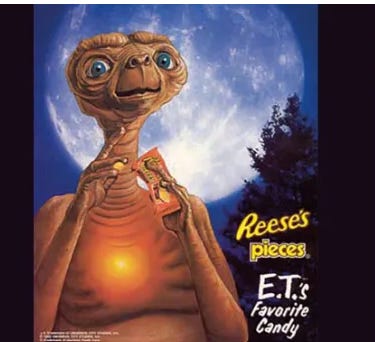A Primer - Rise of Virtual Product Placements (VPP)
1982 - When E.T. famously reached for Reese's Pieces, it wasn't just a win for intergalactic friendship but a masterstroke in product placement that marketers still talk about. This scene didn't just boost Reese's sales; it showed the power of aligning a brand with the right moments, highlighting the impact of smart, memorable marketing.
Product placement is now a $23 billion industry – one of the reasons it’s expanding is that people aren’t paying much attention to traditional advertising. Now, there’s a new player in town: a virtual product placement added post-production.
What is it —>
VPP is a post-production process that dynamically inserts a brand /product into a scene by leveraging AI without being disruptive to the narrative . Placements are added into content post-production, meaning that different brands can be inserted according to the content’s audience, channel, and schedule.
It's really about seamlessly weaving products into the storyline after the cameras have stopped rolling, allowing for a custom-tailored viewing experience
Recent examples - M&M's is digitally added to a bowl on a table in a Bosch episode. Other VPP within Tom Clancy's Jack Ryan. Lexus has also added 3D models of its cars to a music video for Mickey Singh.
Other use cases":
Why its taking off
Viewer preferences -Viewers gravitate toward minimal or nonexistent intrusive advertising. While only 12% of consumers said they enjoyed traditional TV advertisements, a remarkable 79% of consumers responded favorably to VPP in terms of ad awareness, brand awareness, favorability, and consideration according to Kantar research. In-content advertisements are also shown to be more memorable than traditional TV commercials.
Revenue streams - Through virtual product placement, advertisers can increase their audience reach and level of engagement. Products can be strategically positioned within well-liked digital content to give brands greater exposure and association with well-known figures or popular shows
Speed to Market: Traditional product placement entails months of planning to enable seamless product integration. Traditionally, brands needed to invest a large amount of money and time in campaigns which are impossible to iterate after they've been launched
Flexibility - VPP is flexible and enables brands to better curate ad experiences and experiment with newer ways to advertise their products.
Platforms
Amazon - In Amazon’s case, it introduced the VPP ad format to select Prime Video and Freevee series. The VPP ads can appear in a show’s background or foreground, and they can also appear as dynamic in-program ads.
While Amazon’s VPP tool is still in its beta phase, it will allow brands to strategically insert ads into select shows during the post-production process.
NBCU’s Peacock streaming platform is also looking into VPPs through its “In-Scene Ads,” which will allow advertisers to integrate their ads within a show’s relevant scenes during post-production.
Other potential scalable use cases
Cultural localization - VPP can be used to customize product placements for different geographic or demographic markets within the same content. A car driven by a character in an international TV show could be changed to different models or brands to better appeal to viewers in specific countries, enhancing the global appeal of the content and the effectiveness of the advertising
Monetizing Music Videos: Music industry could be a major beneficiary. Artists can incorporate VPP into their music videos, allowing them to seamlessly integrate brands and products post-production. This means artists can focus on creating compelling narratives and visuals without worrying about product placement logistics during filming. For example, a beverage brand could be virtually added to a party scene, or fashion accessories can be added to the artists and dancers, providing additional revenue streams through brand partnerships
AR-enhanced Real World: Through AR apps, users can see virtual billboards overlaid on the real world, offering a new dimension to outdoor advertising by providing additional information or interactive experiences.
We’ve yet to see its full potential, but VPP is slowly proving itself to be a valuable asset for brands and marketers.



